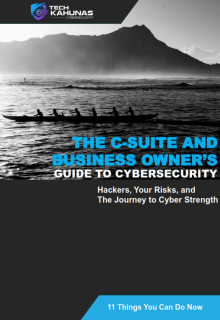
The four elements of the KahunaVision Technology Assessment are:
– Outsourcing –
Are your IT concerns and problems keeping you from being productive? We’ll handle them.
– Modernization –
Want to take advantage of technology trends like AI, cloud applications, and fortified backups?
– Cybersecurity –
Want to strengthen your security and don’t know where to begin? We’re on top of the threats.
– Compliance –
Are your compliance requirements overwhelming? We’ll take those, too.
The Kahuna Shield Service Level Agreement (SLA) will tie it all together.
Tech Kahunas
8451 Miralani Drive Suite C
San Diego, California 92126
Phone: 858-777-0040

Our free cybersecurity guide will tell you what the state of cybersecurity was in 2022, which companies didn’t make it, and what’s on the horizon in 2023 and beyond.
